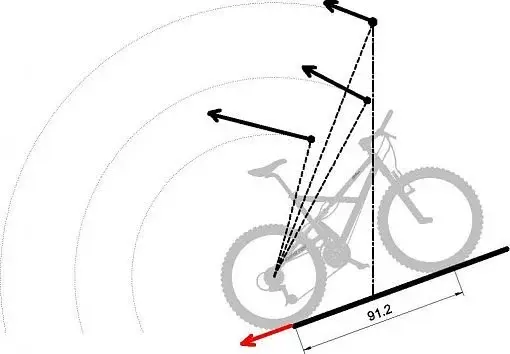- Feedback
- View
Personally I find getting sufficient traction is usually the limiting factor when climbing slopes, when I was in my teens & twenties there was a short patch of 60+ degree slope (yes 2 foot accent for 1 foot horizontal) that me and my mate regularly rode up with a combination of momentum and the back wheel scrabbling for grip. It was impossible to "walk" up, we could just about climb it but needed both hands, good gripping trainers and frequently slipped back down.
I understand the difference between 45 degree and 45% slope, I can ride a 45% slope seated easily enough, I'm 6 foot 3 but I deliberately ride an 18" frame, so I have a stupidly long seat post and a long steerer and bar ends that stretch me out on the bike so I can easily move my weight over the front wheel to keep it down if required.

As you say, a far steeper slope can be ridden when bike has lots of momentum going into the slope. In fact if the slope curves upwards, and the rider is going fast enough an almost vertical slope can be ridden momentarily. Or even beyond vertical as is the case with motorcyclists riding the 'loop-the-loop'

The above diagram shows the direction of the 'torque reaction' vector and how the rider can reduce the magnitude by moving their weight further away and forward of the rear axle. This explains why being tall can help to keep the front wheel planted.
Though accurate for a stationary bicycle the top diagrams are an over simplification as the pedalling forces push upwards against the rider's CoG whose inertia pushes backwards causing more 'load shift' or weight transfer onto the back wheel. This can cause the bike to wheelie even before the CoG moves behind the rear contact patch. There is also a rear wheel torque reaction which further adds to the problem.
The lower the gears used the greater 'load shift' and 'torque reaction' forces that combine to lift the front wheel.
Pedalling with a higher cadence means that there is less time for deceleration in-between pedal strokes. But with hill climbing the use of very low gears increases the 'load shift' and 'torque reaction' forces that induce suspension bob. Very low gears can also overwhelm rear wheel traction.Training yourself to pedal at a higher cadence in a lower gear is a simple way to make climbing easier than bolting on some dubious gizmo that may improve your performance.
I used to use low gears and high cadence for steep climbing but now I find using them more tiring than pushing higher gears. When out training I use as high a gear as I can, to build up muscle strength. Rider's who prefer low cadence hill climbs may like the smoother feel of a device like RotoCranks. But I doubt that it would make them faster. In fact it's likely to make them slower due to the additional weight.I'd say RotorCranks are a solution looking for a problem since the pro peloton have generally adopted higher cadence as the solution to efficient pedaling for hours at a time. I used to be a plodder with a slow cadence style, I can't ride at the 90rpm the pro's do but I pedal faster than I used to as a means to climbing hills effectively. I have a cycle computer with a cadence sensor which helps stop me labouring on climbs..